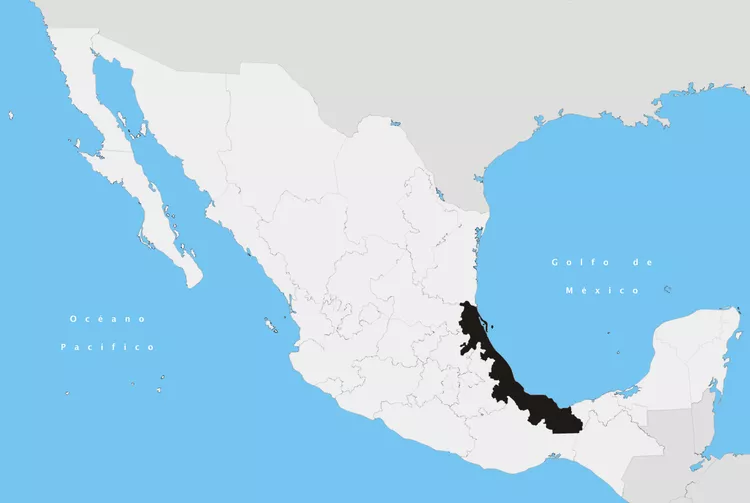Summary of Veracruz State
Veracruz state is a long, thin, crescent-shaped state located along the Gulf of Mexico. It is one of the top three states in Mexico for biodiversity (along with Oaxaca and Chiapas). The state is famous for its beautiful beaches, music, and dance with an Afro-Caribbean influence, as well as delicious seafood specialties. Consequently, it is rich in natural resources and is a leading national producer of coffee, sugarcane, corn, and rice.
Quick Facts about Veracruz State:
- Capital: Xalapa (alternative spelling Jalapa)
- Area: 71,735 km², 3.7% of the national territory
- Population: 6.9 million
- Topography: Ranges from narrow coastal plains to the high mountains of the Sierra Madre, including Pico de Orizaba (Citlaltépetl), the highest peak in the country at 5,636 meters (18,491 feet) above sea level
- Climate: Varied – from cold, snow-capped mountaintops to warm, wet tropical areas on the coast
- Flora: Includes palm, agave, pine and oak forests, mangroves, and grasslands
- Fauna: Home to deer, hare, cacomixtle (raccoon), coyote, chachalaca, and iguanas
- Archaeological Sites: Cempoala, El Tajin
- Fiestas in Veracruz: Carnaval (Puerto de Veracruz), Fiesta de la Candelaria (Tlacotalpan), Noche de Brujas (Catemaco), Cumbre Tajín (Papantla)
- UNESCO World Heritage Sites: Tlacotalpan, El Tajín
- Pueblos Mágicos: Coatepec
The Port of Veracruz
The city of Veracruz, officially known as “Heroica Veracruz,” but more commonly referred to as “El Puerto de Veracruz,” was the first city founded by Spaniards in Mexico. They arrived in 1518 under the command of Juan de Grijalva, and Hernan Cortes came the following year to establish La Villa Rica de la Vera Cruz (Rich City of the True Cross). As the country’s principal port of entry, the city has played a vital role in numerous historical events and is a significant tourist attraction, especially during Carnaval when it is filled with vibrant music and dance invigorated by Caribbean influences.
The State Capital: Jalapa
The state capital, Jalapa (or Xalapa) is a dynamic university town that hosts an excellent anthropology museum containing the second most important collection of Mesoamerican artifacts in Mexico, after the Museo Nacional de Antropologia in Mexico City. Additionally, nearby towns like Coatepec (one of Mexico’s designated “Pueblos Mágicos”) and Xico offer a fascinating blend of local culture and stunning scenery amidst Veracruz’s coffee-growing region.
Further north, Papantla is famous for its vanilla production. The nearby archaeological site of El Tajín is one of Mexico’s major ancient cities, known for its numerous ball courts. Cumbre Tajín, a festival that celebrates the spring equinox, takes place annually in March.
To the south of Veracruz port lies Tlacotalpan, a colonial river port recognized as a UNESCO World Heritage site, founded in the mid-16th century. Beyond that is Lake Catemaco, located in the Los Tuxtlas region, notable for its rich plant and animal life, which includes the Los Tuxtlas Biosphere Reserve and Nanciyaga Ecological Reserve.
The Voladores de Papantla is a cultural tradition of Veracruz acknowledged by UNESCO as part of the Intangible Cultural Heritage of Humanity.
How to Get There
The state’s only international airport is in Puerto de Veracruz (VER). Additionally, there are excellent bus connections throughout the region, making it a convenient destination for travelers.




